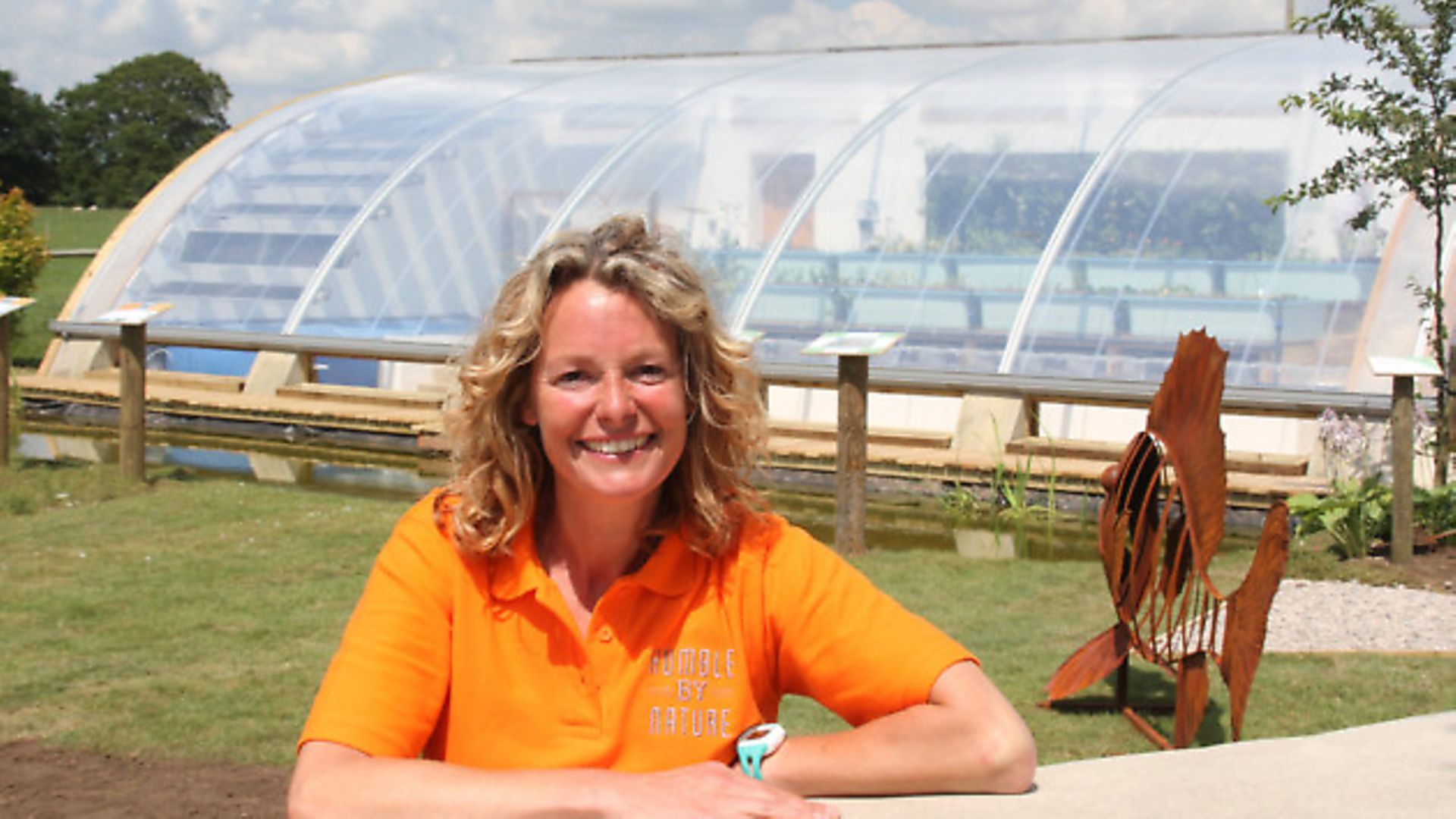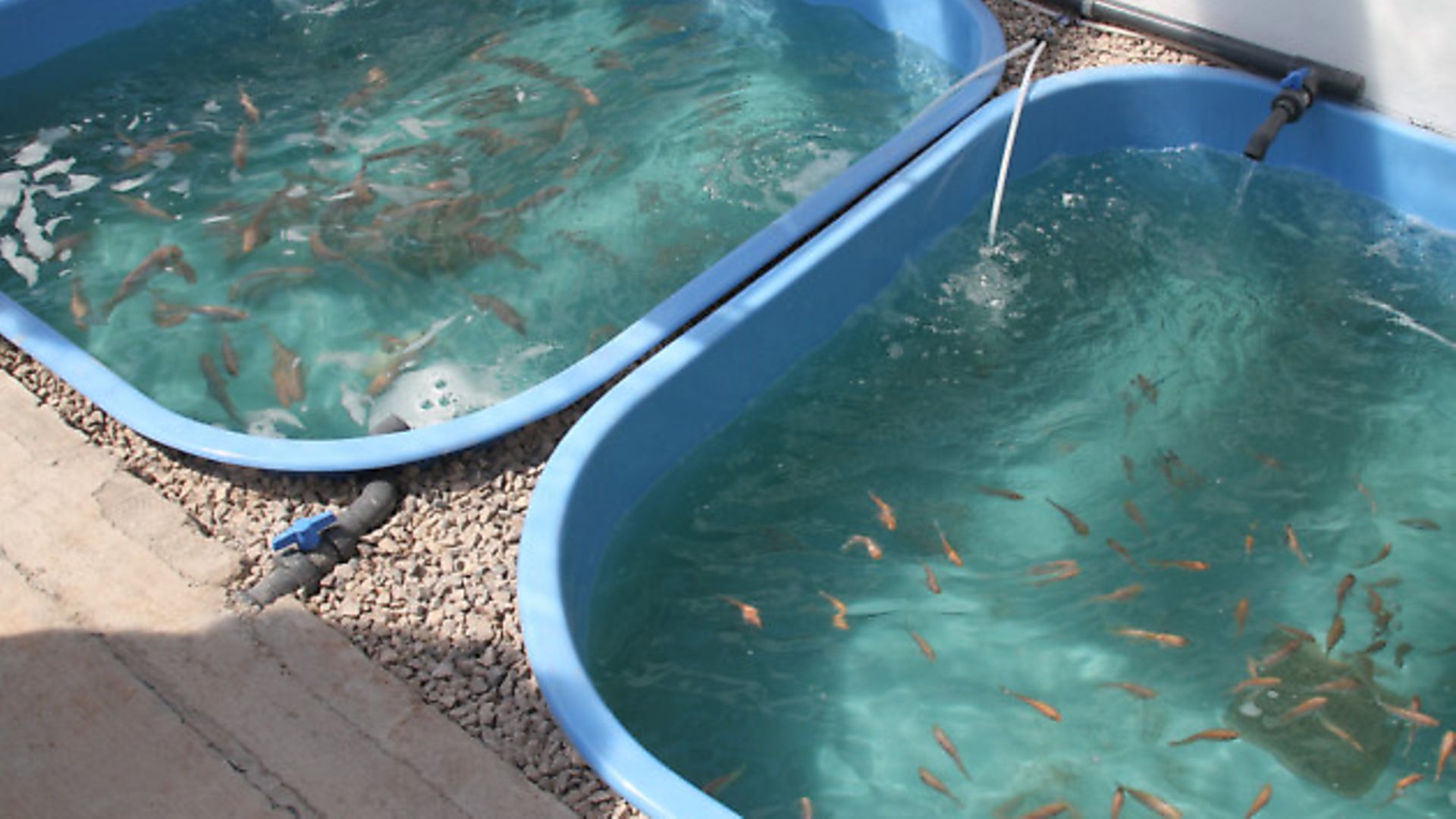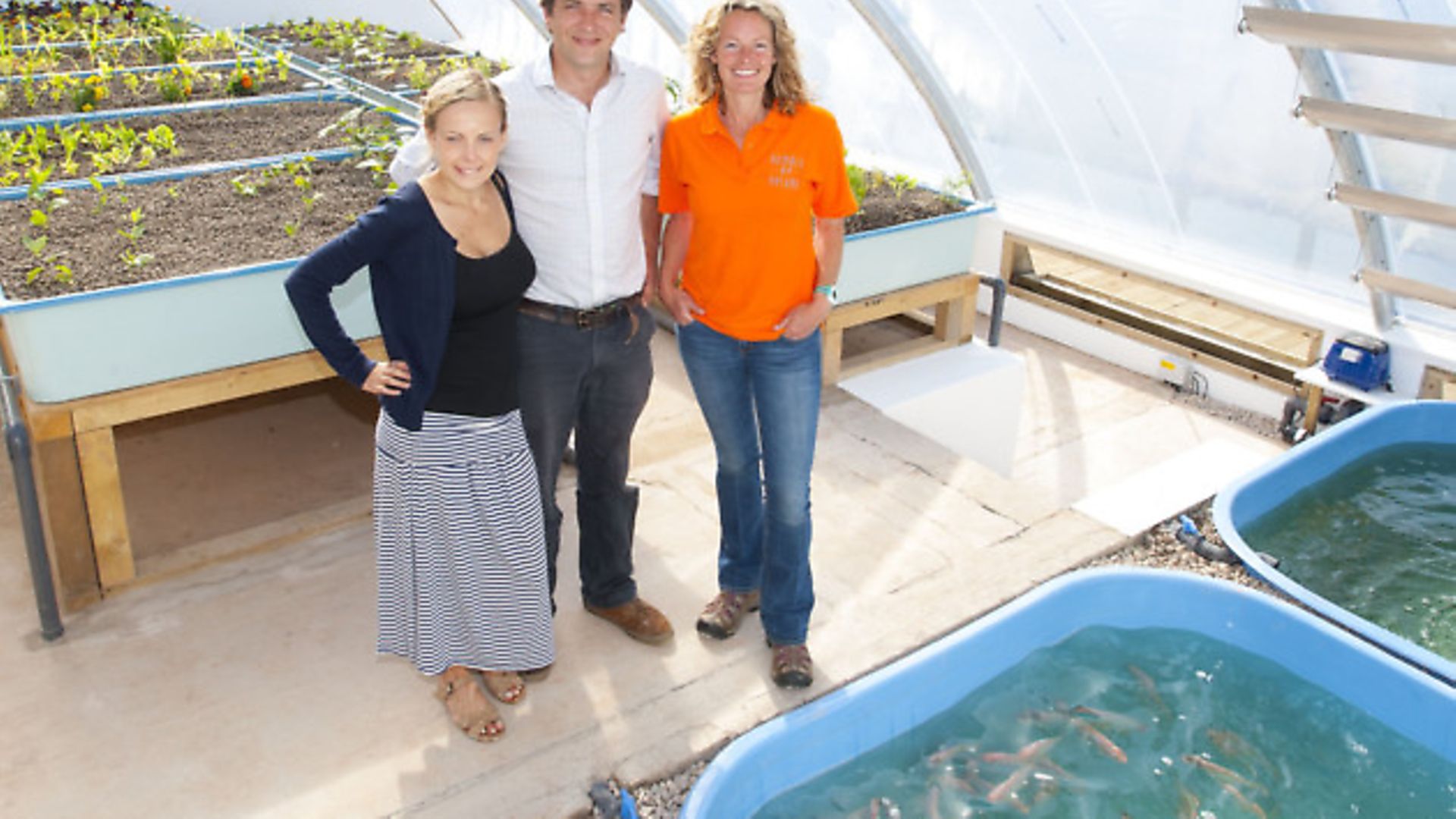Our celebrity columnist Kate Humble has launched a pioneering new venture at her farm in Wales – a sustainable food production system. Liz Shankland went to find out more

Upper Meend Farm appears, on the face of it, to be a typical agricultural holding, just like so many others in the leafy Monmouthshire countryside.
Visitors enter the farmyard, which is flanked by fields filled with grazing sheep and the occasional honking goose. They make their way past the cattle sheds and traditional stone barns, and through the pretty, cottage-style gardens where itinerant hens scratch about for worms.
But then something entirely unexpected stops them in their tracks. Ahead, right next door to the goat field and the duck pond, and just a stone’s throw from the pig paddock, stands what looks like a giant-size polytunnel. Drawing closer, it is almost a polytunnel sliced lengthways, with one solid back wall and two solid sides. Curious. And, hang on a minute – why are there fish swimming around in big blue tanks at one end and quail scuttling around at the other?
Kate Humble, TV presenter and smallholder, laughs loudly and beams with pride. “Isn’t it the most amazing thing you’ve ever seen?” Amazing, yes – and intriguing, too. This rather incongruous see-though structure is the first of its kind in the UK – an aquaponics solar greenhouse. It was devised by biologists Charlie Price and Becky Bainbridge, who are two of the key players in Aquaponics UK, a not-for-profit organisation set up to help design and create ingenious and sustainable food projects like this groundbreaking one at Humble by Nature in the Wye Valley.

“It all started last year, when I was filming a programme in Scotland called the Great Big Energy Saving Challenge,” Kate explains. “People living in a street on the east coast were challenged to cut their gas and electricity consumption by a third in just three weeks. During the filming, I got chatting to a German scientist who was really into using passive solar technology – which involves designing buildings to collect, store, and distribute heat. I said I was interested in using sustainable energy here on the farm, and he said I should look up the term ‘aquaponics’, which I’d never heard of. That led me to Aquaponics UK, where I met Charlie and Becky, who are the most brilliant scientists.”
Freshwater fish
Kate enlisted the help of the Federation of City Farms and Community Gardens (FCFCG) who, through their Tyfu Pobl (Growing People) scheme, provided Welsh Government funding for what turned out to be a £50,000 venture. In her usual infectious, enthusiastic style, Kate roped in help and sponsorship from a wide range of other sources, too. Within a matter of months, using local builders and locally-sourced materials wherever possible, the 12m x 7m greenhouse began to take shape and, by July, it was officially opened.

So what is so exciting about this project? Well, let’s start with the fish. There are three large tanks containing tilapia – a freshwater fish which is highly adaptable to different environmental conditions and also happens to taste really good. In the United States, it already sits just behind tuna, salmon, and Alaskan pollock in the list of most popular seafoods, and is also gaining an appreciative following here in the UK.
Anyone who has kept fish in a tank will know that fish faeces can foul the water very quickly. However, in aquaponics, the waste from the fish is absorbed into the water and then periodically pumped around a series of raised gravel beds to fertilise fruit and vegetables planted in them. As the nutrients are absorbed by the plants’ transport systems, the water is cleansed and purified and can be returned to the fish tanks. When they reach the desired size, the fish – all males, to make management simpler – can be harvested and eaten.
At the moment, while the population is being established, the tilapia are being fed largely on commercial fish food and worms from a composting system at the rear of the greenhouse.
However, the next step is to make the whole process even more sustainable. Waste food from the farm kitchens – mainly fruit and vegetables, but also meat and fish – is being fed to black soldier fly larvae. The larvae are voracious eaters, devouring waste much faster than worms can manage – so it can be eaten before it has the chance to start to rot.
Scientific trials
There is another reason to love the larvae: when they reach the stage in their development where they are ready to pupate, they begin climbing away from the younger larvae. Experts have found that creating a 45 degree slope in the container holding the larvae is perfect for aiding the process: the angle is sufficiently steep to keep the younger larvae in the container, while the older ones (the prepupae) are able to crawl up. When they get to the top, they fall into a collection pot, making harvesting simple. They can then be fed to the fish or – and this is where the quail come in – given to poultry.
“When the whole thing is well-established and working efficiently, it should be an incredibly productive structure,” Kate said. “Scientific trials in Germany with a similar structure have shown that it can produce 250kg of fish a year and 30 to 35kg of fruit and vegetables a week. And all of that from such a relatively small piece of ground. What’s really exciting is that this project could be a model for similar schemes across the UK, helping communities to produce food in a cheap, sustainable way. If we can show how well it works, others will want to follow suit. You could build one of these on a village green, in the grounds of a school, a hospital, or a prison, on a brownfield site, or on a rooftop. There are endless possibilities. It may sound a bit far-fetched, but I really think that, with this kind of innovation, we might not need food banks to feed our growing population.”
Charlie Price admits that there were teething problems with the Humble by Nature build, but he hopes that lessons learned will enable future projects to be completed much more easily, and cheaper. “This was such a learning curve, and there were a lot of start-up costs that we didn’t anticipate, because it was the first of its kind,” he said. “However, now that we have done it, we know that it is highly replicable, and not just at this scale. The beauty of it is that it’s a modular system, so it can be expanded lengthways or reduced in size for smaller sites. Planning permission has been submitted for a commercial one 20 times larger than this in Sussex, but it would be great to see the idea being taken up by community organisations, too. We want to take sustainable, integrated farming to the masses, as well as to farmers who are thinking of diversifying.”
• Humble by Nature is organising courses in aquaponics – from one-day introductions to five-day intensive training sessions for those with serious plans in mind. There will be discounts for members of the Federation of City Farms and Community Gardens See www.humblebynature.com for details
• Advice is also available from Aquaponics UK on their website
www.aquaponics.org.uk
What is aquaponics?
You may have heard of hydroponics – the process of cultivating plants without soil, but using other substances, such as sand, gravel, or liquid, as an alternative growing medium. You may also have heard about aquaculture or aquafarming – the process of rearing aquatic creatures and plants under controlled conditions. Aquaponics combines both methods to create a sustainable food production system.
Aquaponics has gained popularity in countries across the world, particularly in the United States and Australia, where severe drought conditions can be an obstacle to cultivation. Small aquaponic systems are increasingly being installed by keen gardeners, and a quick internet search will reveal numerous homemade set-ups – some based around an average-sized greenhouse and an aquarium – which can be replicated by anyone with a flair for DIY. Materials for an improvised system are easy to find, while tilapia and black soldier fly larvae can be bought cheaply over the internet.
Image(s) provided by:
Archant







